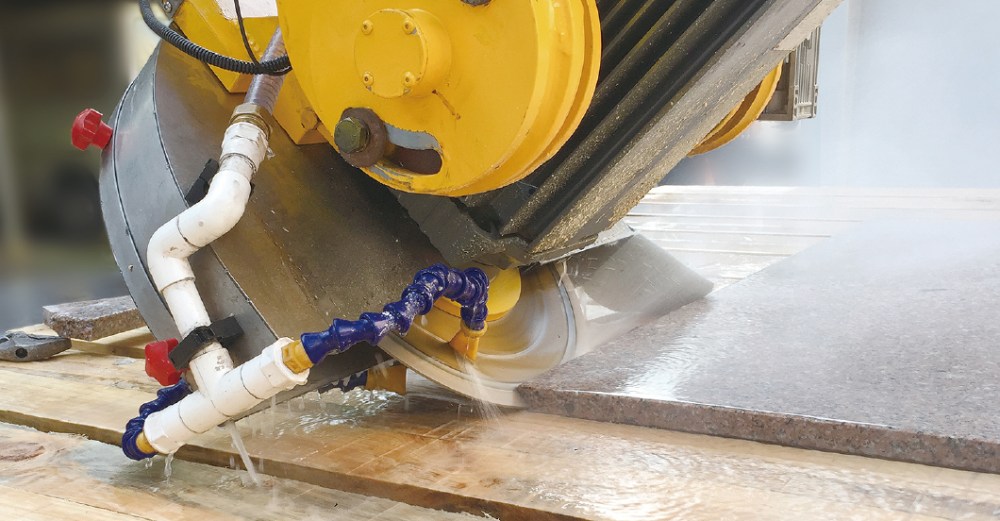The main purpose of granite saw blades is to cut stone. They are widely used in marble and granite cutting and are important processing tools in the stone industry. Of course, the nature of its work determines that the working environment of granite saw blades is relatively harsh.
Granite saw blades determine whether the stone material is neat. Many stone slabs are not cut evenly due to small details that you did not pay attention to during the cutting process. So today, what details of granite saw blades will affect the cutting of stone slabs? Let’s take a look at the small details that Sifeng Tools learned during the cutting process!
Saw blade idling, especially when a new saw blade is used for the first time, needs to be idling for about 10-20 minutes. In the hot summer season, it needs to be idling with water. The purpose is to further eliminate the impact of welding the blade head on the base and enhance the memory of the saw blade to maintain its internal quality under high-speed rotation.
The cut rough material shall not be less than 0.5m3 and shall be placed securely. The bottom surface shall be padded with square wood and firmly packed. The rough material shall be located in the symmetrical position of the workbench to ensure the stability of the workbench and the rough material. There shall be no shaking or trembling.
According to the length, width and height of the rough material, adjust the stroke switch, the lifting and lowering of the saw blade and the stroke of the material cart within a reliable and effective range. The saw blade edge shall be 10-20mm away from the rough material before sawing. After sawing, the sawing edge shall be 20-40mm away from the bottom of the rough material. Before the saw blade carriage moves left and right, the saw blade shall be completely withdrawn from the rough material sawing edge, and the distance shall not be less than 150-200mm to prevent the saw blade from hitting the rough material.
Trial cutting can be carried out only after the saw blade is stable in idling. The saw blade cannot be started when the saw blade edge is in contact with the rough material. The saw blade cannot be stopped during the cutting process. The saw blade must be withdrawn from the sawing edge before it can be stopped.

If the rough material shakes, the cutting should be stopped immediately. If the rough material shakes during cutting, the cutting should be stopped immediately, and the work can be continued only after the rough material is firmly fixed. The rough material cannot be moved arbitrarily during the cutting process.
The saw blade has obvious deceleration or even knife clamping phenomenon. When the granite saw blade is found to have obvious deceleration or even knife clamping phenomenon during cutting, it may be due to belt slippage, loosening of the clamping nut, too deep cutting depth, too fast cutting speed, etc. The saw blade parts should be adjusted in time.
Feed speed The feed speed of the saw blade mainly depends on the performance of the processing material. For each material, there is a certain range of feed speed when the cutting depth is certain. If the speed is too high, the diamond will wear faster or even fall off, causing the saw blade to consume too quickly. If the speed is too low, the saw blade self-sharpening process will not proceed normally, thus “blunting, slipping” and losing cutting ability. In general, the feed speed should be slow when cutting in and uniform when sawing.
The saw blade rotation direction is the same as the stone feeding direction for forward cutting, and the reverse direction is reverse cutting. When reverse cutting, there is an upward vertical force, which forms a tendency to lift the stone. Therefore, in order to stabilize the stone, forward cutting should be used as much as possible under the same conditions. When reverse cutting is used, the cutting depth should be reduced, generally reduced to 1/3-1/2 of the forward cutting.
According to the feedback from the above details, the basic requirements of the cutting process should be selected for stones with low hardness and good cutting performance. You can cut deep and walk slowly, or you can cut shallow and walk quickly. For the same stone and the corresponding saw machine and saw blade, the process parameters of high cutting efficiency, good cutting board quality, and long life of the saw blade and substrate should be used as the standard. The four complement each other and are interdependent. You cannot generalize.
 WANLONG
WANLONG
